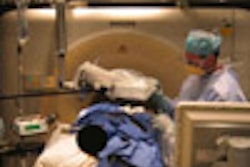In these days of sonographer shortages, it's crucial to keep good, dedicated sonographers. Improving working conditions and showing appreciation can significantly boost sonographer retention rates, according to the experience of Johns Hopkins Hospital (JHH) in Baltimore.
"Learn to balance personal and work life, be flexible with schedules, and understand their needs," said Robert De Jong, radiology technical manager at JHH. He spoke during a session at the 2007 American Institute of Ultrasound in Medicine (AIUM) meeting in New York City.
In 1990 at JHH, the average length of stay for sonographers was two to three years. Sonographers cited call abuse, lack of appreciation, a stressful work week, and pay as factors for leaving, De Jong said.
After a second mass exodus of sonographers, JHH sought to do something about its retention rate. For the first step, the institution talked to sonographers to seek out how to improve their work conditions, De Jong said.
The sonographers said that call made them exhausted, so the institution sought to try different call scenarios to see if that would improve the situation.
In step two, a hospital created a new shift (5 p.m. to 1 a.m.) Monday through Friday, which fortunately proved to be cost-effective, De Jong said. To make it a little more lucrative for sonographers, the hospital also offered a $1 per hour bonus for this shift, and the radiology department also contributed an additional $1 per hour in additional pay.
An internal employee accepted the position, which included more pay and free parking, De Jong said. A backup call schedule was created in case that sonographer was sick or taking time off. Every sonographer is now assigned a day from Monday to Friday in which they would take over in the event that the late-shift sonographer cannot work.
"(It's) a very good win/win situation," he said.
In step three of the process, JHH realized that the amount of weekend work justified starting a new working shift. Sonographers were able to work a 9-to-5 weekend shift in exchange for a day off during the week and a weekend pay differential of $1.25 an hour. This was well received by both employees and administration, De Jong said.
Five years later, employee morale was high, with sonographers feeling more appreciated and respected, De Jong said. There were still some complaints about call abuse, however. In step four, the institution noted that the amount of call pay and overtime justified starting a third shift.
Nine years later, in 2004, JHH had a very stable staff, De Jong said. In addition, the hospital recognized the benefit of keeping trained staff, offering equity raises.
"They realized it was more cost-effective to pay experienced people more money than to train them and watch them walk out the door to the neighboring community hospitals where they got more money," he said.
Employees who have left in the last five years have largely done so for reasons such as a spouse relocation, moving back home, or going to medical school, he noted.
During the time the institution tried to improve the working conditions and quality of life for sonographers, four have resigned for pay reasons, however, De Jong said. Three eventually returned (two within one month), citing the positive work conditions at JHH.
"They found out that money is not everything," he said.
Listening to employees, the institution has added shifts in response to increased weekend work. Currently, the only call hours are from Friday midnight to Saturday 8 a.m. and Saturday midnight to Sunday 8 a.m.
"Call nights have been greatly reduced," he said.
Work conditions
To improve work conditions for sonographers, it's important to talk to employees and find out what they need. "This makes them feel part of the improvement process," De Jong said.
One factor to consider is the balance of time worked versus pay. Reduced call may mean that overtime and pay goes down; that sounds good but may cause problems for employees counting on that money, he said.
Developing a career ladder to assist staff sonographers in becoming senior sonographers is also helpful, according to De Jong.
Having flexibility for individual employees can be valuable for job satisfaction, but it's important to also get buy-in from other employees to avoid resentment, he said.
As a manager, never ask the employee to do something you would not do yourself, he said. And don't stay in your office behind a closed door, De Jong said.
If a staff member resigns, get a copy of the offer letter, he said. This allows for comparison of the whole package rather than just a pay rate.
Also, show employees appreciation, including complimenting them on studies, being interested in their outside life, and bringing back goodies from business trips and vacations, according to De Jong.
"If (sonographers) feel cared about and appreciated, they're more likely not to go looking," he said. "The people we have are very important to keep."
By Erik L. Ridley
AuntMinnie.com staff writer
July 5, 2007
Related Reading
Sonographers: Highly experienced, vastly underappreciated, February 6, 2007
Head and neck surgeons can handle ultrasound, journal article says, January 1, 2007
U.S. government issues update on WRMSDs in sonography, December 25, 2006
The future of ultrasound: Used by many, understood by few, October 27, 2006
3D brings opportunities to sonographers, August 4, 2006
Copyright © 2007 AuntMinnie.com




















